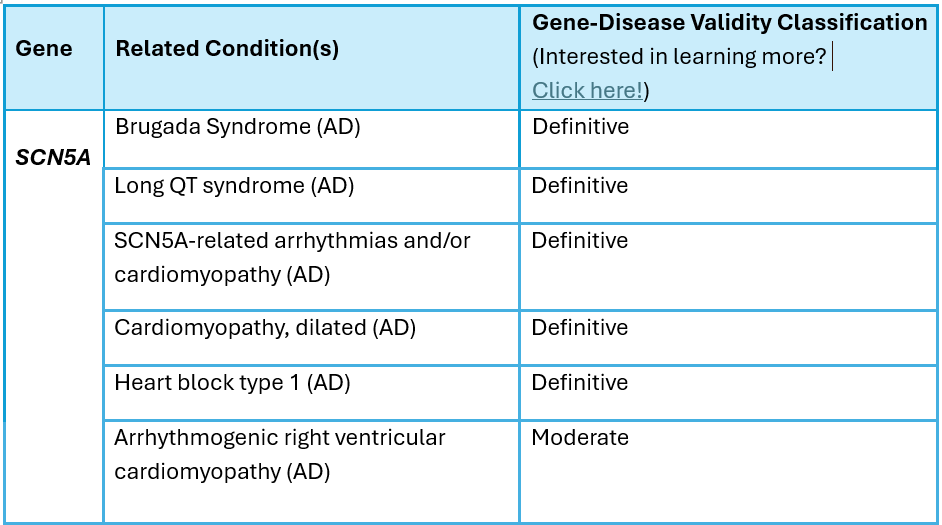
Welcome to the Gene Scene! Each week, we will explore a gene from the ACMG Secondary Findings list—genes identified by the American College of Medical Genetics and Genomics as having clear, actionable health implications. These genes are included because they’re linked to serious but preventable or manageable conditions when identified early. Here, we focus on the condition that led to the gene’s inclusion on the list, providing clear, relevant information that supports your clinic. To subscribe to the Gene Scene, contact your local GSL or send a request to info@ambrygen.com.
To access the Gene Scene archives, visit our blog.
Clinical Phenotype Summary:
The SCN5A gene (NM_198056.2) is located on chromosome 3p22.2, contains 27 coding exons, and encodes the sodium channel protein type 5 subunit alpha. Pathogenic variants in this gene have been associated with a spectrum of SCN5A-related arrhythmias and/or cardiomyopathy including Brugada syndrome, long QT syndrome, arrhythmogenic right ventricular cardiomyopathy, cardiac conduction defect, sick sinus syndrome, atrial fibrillation, and dilated cardiomyopathy (DCM), which are inherited in an autosomal dominant fashion.
SCN5A-related arrhythmias and/or cardiomyopathy disorders are characterized by:
• cardiac arrhythmia
• increased risk for sudden death
Brugada syndrome is defined by:
• ECG cardiac conduction abnormalities in the right precordial leads V1 to V3
o occurring particularly during rest and sleep in apparently healthy and young individuals.
Long QT syndrome is defined by:
• QT prolongation
• T-wave abnormalities.
Arrhythmogenic right ventricular cardiomyopathy is defined by:
• fibrofatty replacement of the right ventricle
• generally an adult-onset disease
Cardiac conduction defect (also known as progressive familial heart block or Lenègre/Lev disease) is defined by:
• progressive alteration of cardiac conduction with right or left bundle branch block
• widening of QRS complexes
• symptoms eventually leading to complete atrioventricular block
SCN5A-related atrial fibrillation is described as:
• rapid, irregular beating of the atria
• without causative risk factors
o such as structural heart disease
Sick sinus syndrome is defined by:
• inappropriate sinus bradycardia
• sinus arrest
• chronotropic incompetence related to dysfunction of the sinoatrial (SA) node
• typically presenting with syncope, presyncope, dizziness, and fatigue
Dilated Cardiomyopathy (DCM) is defined by:
• ventricular dilation
• reduced systolic function
• impaired contractility
Reduced penetrance and variable expressivity, including overlapping phenotypes, are observed. Altered channel function and loss of function have been reported as mechanisms of disease for SCN5A-related arrhythmias and/or cardiomyopathy.
Unique Considerations:
There is significant variability in penetrance associated with SCN5A variants.
Both loss-of-function mutations and mutations that alter function of SCN5A can be disease causing.
Clinical Resources:
Clinician Management Resource for Understanding Your Positive Cardiovascular Genetic Test Result
https://www.ambrygen.com/providers/resources/clinical-materials
Ambry Knows Genes:
Scientific Posters:
• Multigene panel testing for arrhythmias: Diagnostic yield and phenotypic spectrum (HRS 2016)
• More than 95% of positive genetic results for inherited cardiomyopathies and arrhythmias have medical management implications (NSGC 2021)
EducateNext Webinars:
• Evaluation, Risk Stratification, and Management of Arrhythmogenic Cardiomyopathy with Arthur A.M. Wilde, MD, PhD and Cynthia A. James, ScM, PhD, CGC (March 2021)
• Medical Management for Hereditary Cardiomyopathies with John L. Jeffries, MD, MPH, FACC, FAHA, FAAP, FHFSA, FRCPE (Sept 2021)
• Brugada Syndrome with Arthur A.M. Wilde, MD, PhD (May 2022)
• Field Guidance for Genetic Screening in Patients with Cardiomyopathies with Amy Kontorovich, MD, PhD (May 2023)
• ACMG Secondary Findings Cardiology: Getting to the Heart of the Matter with Kelly Radtke, PhD (Sept 2024)
To read more about Ambry’s research on this gene. Visit the Our Research dropdown on our website https://www.ambrygen.com/science.
Citations:
• Benson DW et al. J Clin Invest, 2003 Oct;112:1019-28. PMID: 14523039
• Schwartz PJ. J Intern Med, 2006 Jan;259:39-47. PMID: 16336512
• Meregalli PG et al. Heart Rhythm, 2009 Mar;6:341-8. PMID: 19251209
• Remme CA. J Physiol, 2013 Sep;591:4099-116. PMID: 23818691
• Verkerk AO et al. Front Cardiovasc Med, 2018 Oct;5:137. PMID: 30327767
• Brugada R et al. GeneReviews. 2005 Mar 31 [Updated 2022 Aug 25]. PMID:20301690
• Hershberger RE et al. GeneReviews. 2007 Jul 27 [Updated 2023 May 11]. PMID: 20301486
• McNally E et al. GeneReviews. 2005 Apr 18 [Updated 2023 May 11] PMID: 20301310
• Groffen AJ et al. GeneReviews. 2003 Feb 20 [Updated 2024 Mar 21]) PMID: 20301308
Ambry Genetics Gene-Disease Validity Scheme
Each week, we explore a gene from the ACMG Secondary Findings list—genes identified by the American College of Medical Genetics and Genomics as having clear, actionable health implications. These genes are included because they’re linked to serious but preventable or manageable conditions when identified early.
To learn more about the ACMG Secondary Findings list, click here.




